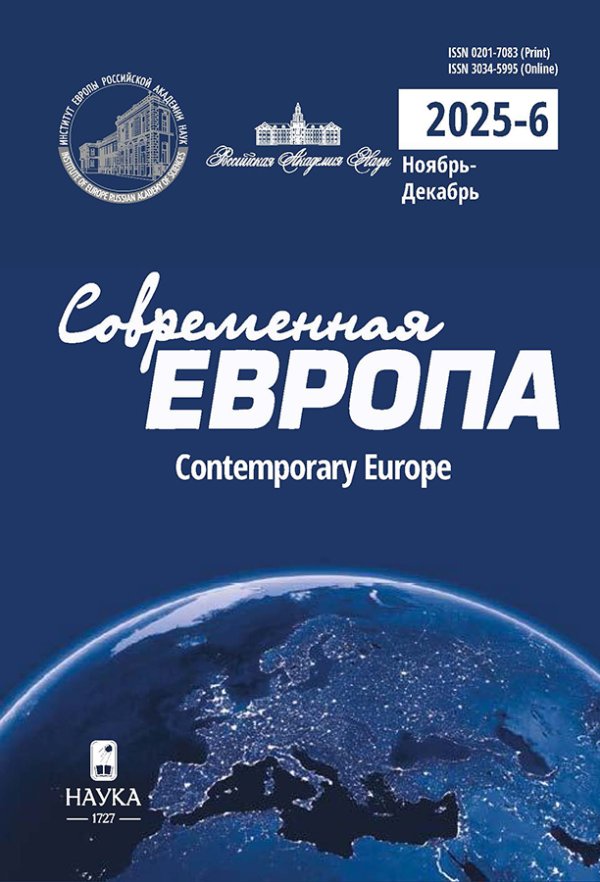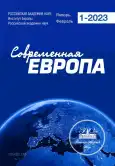Monetization of emissions reductions in the EU in the context of carbon border adjustment mechanism
- Authors: Varnavskii V.G.1
-
Affiliations:
- Primakov Institute of World Economy and International Relations Russian Academy of Sciences(IMEMO)
- Issue: No 1 (115) (2023)
- Pages: 74-87
- Section: Articles
- URL: https://journals.rcsi.science/0201-7083/article/view/144687
- DOI: https://doi.org/10.31857/S0201708323010060
- EDN: https://elibrary.ru/OSAVHS
- ID: 144687
Cite item
Full Text
Abstract
About the authors
Vladimir Gavrilovich Varnavskii
Primakov Institute of World Economy and International Relations Russian Academy of Sciences(IMEMO)
Email: varnavsky@imemo.ru
Moscow, Russia
References
- Белов В.Б. (2021) Дебаты в ЕС о Механизме трансграничного углеродного регулирования. Европейский союз: факты и комментарии. № 103. С. 53-58. URL: http://aevis.ru/upload/ckeditor/files/103.pdf
- Гайда И., Доброславский Н., Ляшик Ю., Данеева Ю., Мельников Ю. (2021) Европейский механизм пограничной углеродной корректировки - ключевые вопросы и влияние на Россию. Центр энергетики Московской школы управления СКОЛКОВО, Сколково. 50 с. URL: https://energy.skolkovo.ru/downloads/documents/SEneC/SKOLKOVO_EneC_RU_CBAM.pdf (дата обращения: 26.07.2022)
- ИПЕМ (2021) Трансграничное углеродное регулирование в ЕС: как не допустить дискриминации российских экспортёров. Аналитический доклад. 52 с. URL: http://www.ipem.ru/files/20210531_ipem_doklad_polnyy_tekst.pdf
- Невская А.А., Баронина Ю.А. (2021) Трансграничное углеродное регулирование: новый контекст отношений России и ЕС. Современная Европа. № 6. С. 63-74. DOI: http://dx.doi.org/10.15211/soveurope620216374
- Cosbey A., Droege S., Fischer C., Munnings C. (2019) Developing Guidance for Implementing Border Carbon Adjustments: Lessons, Cautions, and Research Needs from the Literature. Review of Environmental Economics and Policy. No. 13(1). P. 3-22. DOI: https://doi.org/10.1093/reep/rey020
- European Commission, Directorate-General for Budget (2017) Future financing of the EU: final report and recommendations of the High Level Group on Own Resources. Publications Office of the European Union, Luxembourg, Luxembourg. 101 p. DOI: doi/10.2761/36070
- Klemetsen M.E., Rosendahl K.E., Jakobsen A.L. (2020) The impacts of the EU ETS on Norwegian plants' environmental and economic performance. Climate Change Economics. Vol. 11. No. 1, рр. 1-32. DOI: https://doi.org/10.1142/S2010007820500062
- Osberghaus D., Heindl P., Sommerfeld K. and Höfling H. (2016) KfW/ZEW CO2 Barometer 2016 - Carbon Edition: How the EU ETS can contribute to meeting the ambitious targets of the Paris Agreement. KfW Bankengruppe, Frankfurt am Main, Germany. 30 р.
- Römer D., Schwarz M., Liem E (2021) The EU's carbon border adjustment: A trade barrier or an opportunity for global climate action? KfW Research Focus on Economics. No. 345. 9 p.
- UNCTAD (2021) A European Union Carbon Border Adjustment Mechanism: Implications for developing countries. 30 р. URL: https://unctad.org/system/files/official-document/osginf2021d2_en.pdf (дата обращения: 26.07.2022)
- Zhong J., Pei J. (2022а) Beggar thy neighbor? On the competitiveness and welfare impacts of the EU's proposed carbon border adjustment mechanism. Energy Policy. Vol. 162. DOI: https://doi.org/10.1016/j.enpol.2022.112802
- Zhong J., Pei J. (2022b) Border Carbon Adjustment: A Systematic Literature Review of Latest Developments. 23 р. DOI: http://dx.doi.org/10.2139/ssrn.4128234
Supplementary files










